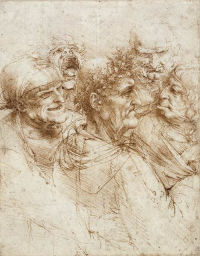
- Enlarge
- Zoom & explore
- The Royal Collection © 2005, Her Majesty Queen Elizabeth II
Study of five characters c1494
This drawing is often described as the finest of Leonardo’s caricature drawings, but strictly speaking, not all of the figures can be classed as caricatures.
The compositional arrangement is also not typical of Leonardo’s caricature drawings. In the centre is a bald old man of the classical type seen in profile crowned with a wreath of laurel leaves. He is surrounded by various figures, all of a particularised type. To the left, an elderly, grinning woman with a huge chin is shown putting her right arm around the central figure.
On the right, a figure with long wavy hair, a huge under-lip and receding chin looks to the left. Behind on the left a figure throws its head back, its open mouth suggests that it is yelling, while to the right an old man is shown almost full-face with a placid expression.
The meaning of the drawing is difficult to detect. The figures are unlikely to represent the “four temperaments” as was once proposed, not least of all because there are five. They do however correspond to Leonardo’s advice about mixing the “conditions of man” in close proximity for effect.
The drawing may also relate to the tradition of burlesque poetry, as practised at the Milanese court. Ironic poems that mocked the ugly and idiotic through a knowing distortion of sophisticated love poetry were a favourite form of courtly entertainment. It is possible that Leonardo’s drawing has a similar humorous or ironic intent.
A narrative interpretation has also been suggested whereby the central “crowned” character is being encouraged by his accomplices to parade himself as something he is not, as a sort of “king of fools”.
Three of the figures appear in a Flemish painting of a mock marriage that may imitate a work by the artist Quinten Massys who worked in Antwerp during the early 16th century, and who produced numerous paintings based on Leonardo’s drawings.
- Medium Pen and ink on paper
- Size 26 x 20.5 cm
- Location The Royal Collection
